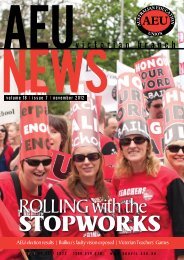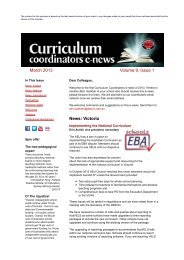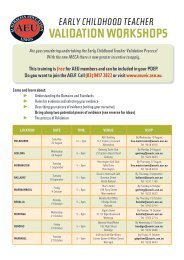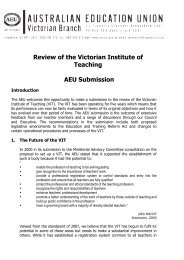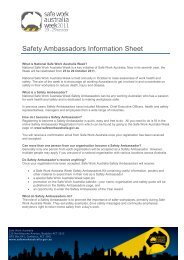Removing asbestos in workplaces - Compliance ... - WorkSafe Victoria
Removing asbestos in workplaces - Compliance ... - WorkSafe Victoria
Removing asbestos in workplaces - Compliance ... - WorkSafe Victoria
You also want an ePaper? Increase the reach of your titles
YUMPU automatically turns print PDFs into web optimized ePapers that Google loves.
General requirements for all <strong>asbestos</strong> removal175. <strong>WorkSafe</strong>’s Workplace amenities and work environment compliance code statesthat employees who undertake work which requires strenuous effort, <strong>in</strong>volvespossible exposure to <strong>in</strong>fectious agents or other contam<strong>in</strong>ants or leaves themdirty or smelly, need to have access to showers before leav<strong>in</strong>g work. This meansthat even though the <strong>asbestos</strong> removal aspect of the work may not requirepersonal decontam<strong>in</strong>ation to <strong>in</strong>clude decontam<strong>in</strong>ation units (as detailed onpage 49), access to showers before leav<strong>in</strong>g work may still be required. Personalwash<strong>in</strong>g and hygiene are essential (particular attention needs to be paid to thehands, f<strong>in</strong>gernails, face and head).176. Personal decontam<strong>in</strong>ation must be undertaken each time employees leave the<strong>asbestos</strong> work area. Personal decontam<strong>in</strong>ation needs to be performed with<strong>in</strong>the <strong>asbestos</strong> work area where re-contam<strong>in</strong>ation cannot occur.177. Asbestos-contam<strong>in</strong>ated personal protective cloth<strong>in</strong>g should not be transportedoutside the <strong>asbestos</strong> removal area except for disposal or launder<strong>in</strong>g purposes.178. Before personal protective cloth<strong>in</strong>g and footwear worn dur<strong>in</strong>g <strong>asbestos</strong> removalwork are removed, they need to be decontam<strong>in</strong>ated to the po<strong>in</strong>t where thegeneration of airborne dust from the subsequent handl<strong>in</strong>g of the cloth<strong>in</strong>g andfootwear is m<strong>in</strong>imised. This preferably needs to be done by vacuum<strong>in</strong>g with aHEPA-fitted vacuum cleaner to remove any <strong>asbestos</strong> fibres (refer to page 29).Footwear also needs to be wet-wiped.179. Respiratory protective equipment can only be removed after:• decontam<strong>in</strong>at<strong>in</strong>g personal protective cloth<strong>in</strong>g and footwear(as described above)• bagg<strong>in</strong>g personal protective cloth<strong>in</strong>g for disposal (or launder<strong>in</strong>g)• complet<strong>in</strong>g personal wash<strong>in</strong>g.180. Any contam<strong>in</strong>ated PPE used while carry<strong>in</strong>g out <strong>asbestos</strong> removal workmust not be taken home.181. If friable ACM is be<strong>in</strong>g removed, the decontam<strong>in</strong>ation procedures describedon page 49 must be followed. Exceptions to this generally <strong>in</strong>clude ‘glove bag’,‘wrap and cut’ (described on page 64) and friable gasket removal jobs, wherethe decontam<strong>in</strong>ation process outl<strong>in</strong>ed <strong>in</strong> paragraphs 186 to 193 is likely tobe satisfactory.182. ‘M<strong>in</strong>i enclosure’ removals may require a comb<strong>in</strong>ation of the personaldecontam<strong>in</strong>ation procedure outl<strong>in</strong>ed <strong>in</strong> paragraphs 184 to 190 and page 60.Removal of small quantities of non-friable ACM183. For the purpose of this section, a small quantity of non-friable ACM is:• any quantity permitted to be removed by an unlicensed person• ACM cladd<strong>in</strong>g on an average size house.184. Where small quantities of non-friable ACM are be<strong>in</strong>g removed, a competentperson may decide that the personal decontam<strong>in</strong>ation procedure (outl<strong>in</strong>ed <strong>in</strong>paragraphs 186 to 191) can safely be used <strong>in</strong>stead of a full decontam<strong>in</strong>ation unit.This decision is made based on a risk assessment that takes <strong>in</strong>to account the:• condition of the ACM• difficulty <strong>in</strong> perform<strong>in</strong>g the removal• level of airborne dust likely to be generated• available clean<strong>in</strong>g/wash<strong>in</strong>g facilities at the site• duration of the task.<strong>WorkSafe</strong> <strong>Victoria</strong> <strong>Compliance</strong> code / <strong>Remov<strong>in</strong>g</strong> <strong>asbestos</strong> <strong>in</strong> <strong>workplaces</strong> 35



